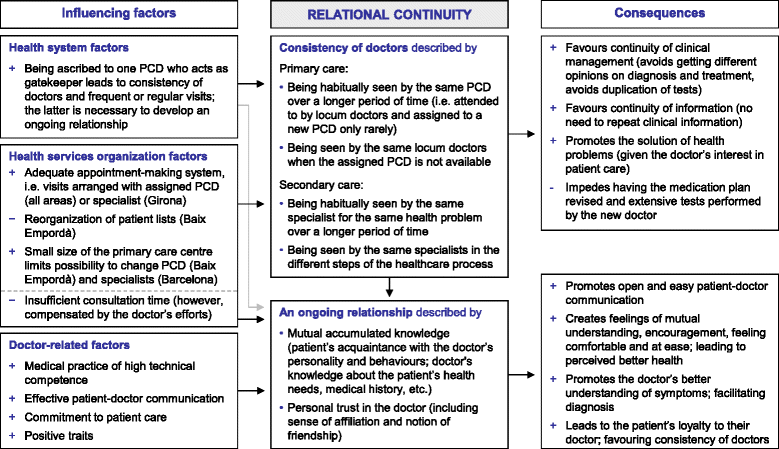Relational continuity with primary and secondary care doctors: a qualitative study of perceptions of users of the Catalan national health system
- PMID: 29631622
- PMCID: PMC5891958
- DOI: 10.1186/s12913-018-3042-9
Relational continuity with primary and secondary care doctors: a qualitative study of perceptions of users of the Catalan national health system
Erratum in
-
Correction to: Relational continuity with primary and secondary care doctors: a qualitative study of perceptions of users of the Catalan national health system.BMC Health Serv Res. 2018 Jun 11;18(1):436. doi: 10.1186/s12913-018-3268-6. BMC Health Serv Res. 2018. PMID: 29890978 Free PMC article.
Abstract
Background: In the current context of increasingly fragmented healthcare systems where patients are seen by multiple doctors in different settings, patients' relational continuity with one doctor is regaining relevance; however little is known about relational continuity with specialists. The aim of this study is to explore perceptions of relational continuity with primary care and secondary care doctors, its influencing factors and consequences from the viewpoint of users of the Catalan national health system (Spain).
Methods: We conducted a descriptive-interpretative qualitative study using a two-stage theoretical sample; (i) contexts: three healthcare areas in the Catalan national health system with differing characteristics; (ii) informants: users 18 years or older attended to at both care levels. Sample size (n = 49) was reached by saturation. Data were collected by individual semi-structured interviews, which were audio recorded and transcribed. A thematic content analysis was carried out segmenting data by study area, and leaving room for new categories to emerge from the data.
Results: Patients across the areas studied generally experienced consistency of primary care doctors (PCD), alongside some inconsistency of specialists. Consistency of specialists did not seem to be relevant to some patients when their clinical information was shared and used. Patients who experienced consistency and frequent visits with the same PCD or specialist described and valued having established an ongoing relationship characterised by personal trust and mutual accumulated knowledge. Identified consequences were diverse and included, for example, facilitated diagnosis or improved patient-doctor communication. The ascription to a PCD, a health system-related factor, facilitated relational continuity with the PCD, whereas organizational factors (for instance, the size of the primary care centre) favoured consistency of PCD and specialists. Doctor-related factors (for example, high technical competence or commitment to patient care) particulary fostered the development of an ongoing relationship.
Conclusions: Consistency of doctors differs depending on the care level as does the relevance attributed to it. Most influencing factors can be applied to both care levels and might be addressed by healthcare managers to foster relational continuity. More research is needed to fully understand the relevance patients assign to relational continuity with specialists.
Keywords: Continuity of patient care; Patient perspective; Patient-doctor relationship; Primary health care; Qualitative research; Secondary health care; Spain; Trust.
Conflict of interest statement
Ethics approval and consent to participate
The study got approved by the Clinical Research Ethical Committee of the Parc de Salut Mar (2010/412/1). Ethical considerations were taken into account during data collection and analysis. Any questions asked about the study by the participant were discussed in full and the consent form was signed before the interview. Users were informed that participation was entirely voluntary and would not affect their care received in any way, and that withdrawal was possible at any point. Respondent names were changed during analysis and other strong identifiers were altered in the quotations used.
Consent for publication
Not applicable.
Competing interests
The authors declare that they have no competing interests.
Publisher’s Note
Springer Nature remains neutral with regard to jurisdictional claims in published maps and institutional affiliations.
Figures
References
-
- Reid R, Haggerty JL, McKendry R. Defusing the confusion: concepts and measures of continuity of healthcare. Ottawa: Canadian Health Services Research Foundation; 2002.
Publication types
MeSH terms
Grants and funding
LinkOut - more resources
Full Text Sources
Other Literature Sources


